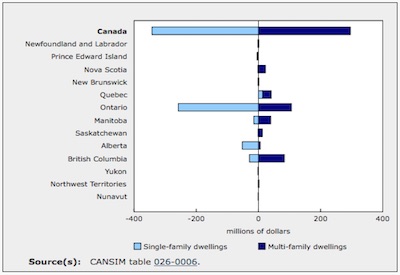Value of Building Permits Rises 2.5% in June

August 15, 2017
Canadian municipalities issued $8.1 billion worth of building permits in June, up 2.5% from May and the second highest value on record.
Higher construction intentions for multi-family dwellings and commercial buildings were mainly responsible for the national increase.
All building components reported gains in June, except for single-family dwellings. Month-to-month changes by jurisdiction are captured in the chart.
Provinces and census metropolitan areas: Quebec posts gains in all components
The total value of building permits rose in six provinces in June, led by Quebec and Manitoba. Meanwhile, construction intentions were up in 14 of 36 census metropolitan areas (CMAs), led by Toronto, Montreal and Winnipeg. Hamilton reported the largest decline in June (-60.0%). However, this followed a notable gain in May. In Quebec, the value of permits was up 12.3% to $1.5 billion in June, a fourth consecutive monthly increase. Gains were spread across all building components, with the largest increase in the commercial component (+25.2% to $308.9 million). In addition, construction intentions for industrial structures rose 32.3% to $152.3 million, the highest value since June 2014 and the third consecutive month the total value has exceeded $100 million.
The value of building permits for Manitoba rose 40.4% to $318.9 million in June. The increase primarily stemmed from gains in the CMA of Winnipeg. The value of building permits for the Winnipeg CMA increased 54.0% in June to $255.6 million, the highest value on record. The value of residential permits rose 16.0% to $137.5 million, marking the fifth time in the past six months where the value exceeded $100 million. The increase in construction intentions for residential structures in the Winnipeg CMA coincided with the implementation of the City of Winnipeg’s new Impact Fee. The fee came into effect on May 1, 2017 and caused an increase in permit applications prior to this date that are still being approved by the city.
Residential sector: decline in single-family component moderated by gain in multi-family dwellings
The value of residential building permits fell 0.9% in June to $5.0 billion, the fourth decrease in five months. The decline was mainly the result of lower construction intentions in four provinces, notably Ontario. In June, the value of permits for single-family dwellings decreased 12.5% to $2.4 billion. Seven provinces registered declines, with Ontario being the main contributor to the decrease.
Conversely, construction intentions for multi-family dwellings rose 12.5% in June to $2.7 billion, marking a third consecutive monthly increase. Seven provinces registered gains, led by Ontario and British Columbia.
Non-residential sector: all components register increases
Municipalities issued $3.0 billion worth of building permits for non-residential structures in June, up 8.8% from May. This marked the fourth consecutive monthly increase. Of the five provinces that posted gains, only Ontario, Quebec and Manitoba registered increases in all three non-residential components.
In the commercial component, the value of permits rose 13.0% to $1.7 billion in June, a second consecutive monthly increase. The gain was largely attributable to higher construction intentions for office buildings and student residences in Ontario.
The value of building permits issued for industrial structures was up 6.3% to $573.5 million in June, a fourth consecutive monthly increase. The national increase was led by Quebec and was largely attributable to higher construction intentions for maintenance buildings.
The institutional component increased 2.1% to $749.3 million in June, with gains posted in four provinces. The increase primarily stemmed from the construction intentions of educational structures and hospitals in Ontario.
Second quarter 2017
Canadian municipalities issued $23.0 billion worth of building permits in the second quarter of 2017, up 10.4% compared with the second quarter of 2016. All building components reported gains except for institutional structures.Led by multi-family dwellings, construction intentions for residential dwellings rose 11.0% from the second quarter of 2016 to the second quarter of 2017, to $14.7 billion. The value of non-residential building permits increased 9.3% to $8.4 billion, led by the industrial component.
Source: Statistics Canada, http://www.statcan.gc.ca/daily-quotidien/170809/dq170809a-eng.htm

















